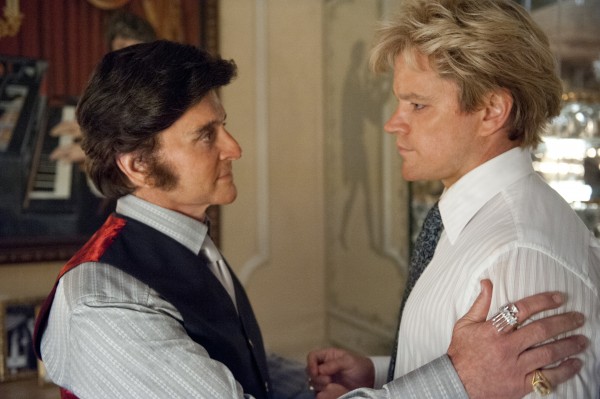
Douglas, left, as Lee Liberace, and Matt Damon as Scott Thorson.
That fact has been largely forgotten in the 25 years since he died — still closeted! — of complications from AIDS. By the end (hell, decades before it), he had become a caricature, but the image of the facelifted, lisping Vegas showboy has obscured his humanity.
So its especially impressive that a bunch of straight guys — director Steven Soderbergh, screenwriter Richard LaGravanese, and actors Matt Damon and Michael Douglas — have done do an astonishing job of capturing the truth of gay men in the pre-AIDS, barely-post-Stonewall decade of the 1970s with Behind the Candelabra, the HBO biopic debuting Sunday at 9. They could have soft-pedaled the sex; they could have idealized and mystified the era; they could have taken any number of “safer” routes. Instead, they told a story with such a savvy understanding of gay culture, you might think you’re watching a documentary.
 That’s especially true in the early scenes, when Soderbergh shows the coded messages (both subtle and overt) that gays used to communicate, from the houseboy who bends over a little too long to the pronoun-shifting in public. It’s easy to forget how back then — and we’re not talking that long ago — gay culture was both underground and so alien to hetero society that some gays they could hide in plain sight. To the mainstream, flaming queens like Liberace and Paul Lynde weren’t “gay,” they were “flamboyant” and “artsy.” That perception fuels a funny early line when Damon’s character, Scott Thorson, is gobsmacked to learn none of the straight families watching Liberace’s Vegas act realize he’s gay.
That’s especially true in the early scenes, when Soderbergh shows the coded messages (both subtle and overt) that gays used to communicate, from the houseboy who bends over a little too long to the pronoun-shifting in public. It’s easy to forget how back then — and we’re not talking that long ago — gay culture was both underground and so alien to hetero society that some gays they could hide in plain sight. To the mainstream, flaming queens like Liberace and Paul Lynde weren’t “gay,” they were “flamboyant” and “artsy.” That perception fuels a funny early line when Damon’s character, Scott Thorson, is gobsmacked to learn none of the straight families watching Liberace’s Vegas act realize he’s gay.
It’s during that scene where Scott first meets Liberace (Douglas), 40 years his senior, and becomes instantly his twink-du-jour. Liberace’s friends predict the relationship won’t last longer than any of his other infatuations, but Scott proves them wrong, and they stuck together for six years (hey, that’s long in gay-years). Many viewers might recall that Thorson sued “Lee” for palimony, suggesting a bitter end to the affair, but that’s only a fraction of the plot of the telefilm; even smaller is Lee’s illness and eventual death. This isn’t an AIDS movie, nor a courtroom drama; it’s a serious exploration of a gay romance fueled by fame, drugs and the oppressiveness of the closet.
 Because Damon and Douglas are straight, it would be easy to criticize their performances as camp stereotypes, or even gay-for-pay acting “challenges” where they nevertheless play it cool. Neither assessment is fair. They throw themselves wholeheartedly into creating fully rounded characters. Sure, Liberace was effeminate and droll to a kitschy degree, and Douglas rolls in the furs and sequins like a pig in mud, but his authenticity is never in question. (The makeup is astonishing, especially with Douglas.)
Because Damon and Douglas are straight, it would be easy to criticize their performances as camp stereotypes, or even gay-for-pay acting “challenges” where they nevertheless play it cool. Neither assessment is fair. They throw themselves wholeheartedly into creating fully rounded characters. Sure, Liberace was effeminate and droll to a kitschy degree, and Douglas rolls in the furs and sequins like a pig in mud, but his authenticity is never in question. (The makeup is astonishing, especially with Douglas.)
And, frankly, you do have to admire what Douglas and Damon do, from fairly explicit sex scenes (more exact: scenes of sexual intimacy) to Damon roaming around in a rock-hard body dressed only in a studded thong to Douglas often shirtless and toupee-less, these are the kinds of roles awards ache to recognize.
They’re not the only ones. Rob Lowe as a serpentine plastic surgeon, Scott Bakula as a moustachioed leather daddy and Debbie Reynolds as Liberace’s mom are all nearly unrecognizable and in turn sort of brilliant.
The conceit of the plot — ingenue is lured into the ravishing world of an older Hollywood celeb, only to be corrupted and tossed aside — is a direct send up of classics like Sunset Boulevard, but despite the familiar tropes, it’s forever fresh. This Candelabra shines a light on gay culture in a fascinating way.











